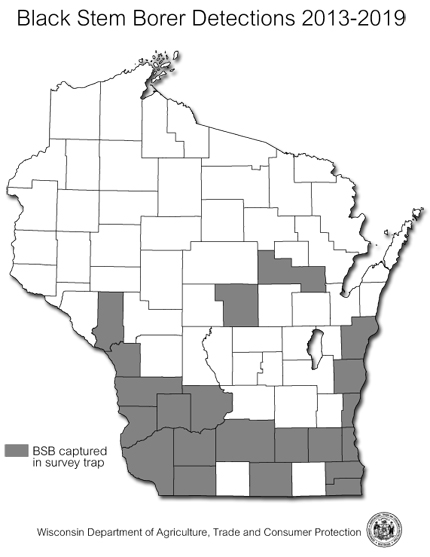
 |
|
|
Fruits
Volume 64 Number 9 Date 06/27/2019 APPLE MAGGOT - Emergence of adults is anticipated in the next two weeks. Initial apple maggot treatments should begin 7-10 days after the first fly is captured on a yellow sticky trap and immediately if the fly is found on a red sphere, with later sprays following at 10- to 14-day intervals as long as flies are appearing on traps. A trapping density of one trap every 200-300 feet placed along the perimeter row is suggested. Orchards with past severe AM problems should also place a few traps in the orchard interior. The economic threshold for apple maggot control is one fly per unenhanced trap per week or five flies per enhanced trap per week. BLACK STEM BORER - This Asian ambrosia beetle (Xylosandrus germanus) was identified on June 4 in an apple tree in a Lafayette County orchard. The infested tree was showing symptoms of decline including wilted and drooping leaves, and about 20 borer holes were noted in the trunk. Several of the holes had protruding columns of frass indicative of ambrosia beetle infestation. Black stem borer attacks a wide range of fruit trees and hardwoods, has been documented by DATCP in 21 Wisconsin counties since 2013. Until the Lafayette County report, there had been no confirmed cases of apple tree damage in the state. Orchards in Michigan, Ohio and other northeastern states have had issues with this pest in the last few years, and in western New York, the beetles have reportedly killed large numbers of apple trees. CODLING MOTH - The spring flight has peaked in most southern Wisconsin orchards, though trap counts remain high at some sites. Economic captures of five or more moths per trap per week were reported from 11 of 27 cooperating locations (41%) from June 20-26. Apple growers are advised to continue monitoring degree days and CM trap counts until 650-700 units (modified base 50°F) have accumulated from the spring biofix to determine if additional late flights require treatment. Most orchards south of La Crosse have accumulated about 325-410 degree days since June 1 when the biofix was set at warmer southern sites. Signs of fruit damage are becoming apparent, and scouting fruits for tiny, circular entry wounds should be underway. SAN JOSE SCALE - Crawlers are emerging from beneath scales in southern and western Wisconsin orchards. Known "hotspots," or areas of suspected high SJS pressure, can be monitored using black electrical tape on scaffold branches. The tape should be wrapped adhesive side-down, and a thin layer of petroleum jelly applied to the outer side of the tape. Captures of 10-15 crawlers on several taped branches over the course of a few days, or 10 crawlers on one tape, may warrant application. Treatments should be applied once the yellow crawlers are active, but before their white, waxy coverings (white cap stage) start to form on the leaves and branches. Conventional products for summer control include Esteem (pyriproxyfen) or Movento (spirotetramat). Options for organic growers are summer oil and encouraging biological control. POTATO LEAFHOPPER - Levels of this insect have increased abruptly in the last two weeks. Non-bearing, one- to two-year-old apple trees are most susceptible to feeding by leafhopper adults and nymphs and should be inspected for upwards leaf cupping and yellowing of terminal shoots. Treatment is justified at levels of one or more nymphs per leaf when symptoms are developing. DOGWOOD BORER - This clearwing moth began appearing in pheromone traps last week. The traps do not indicate the need for control, but instead signal when to begin scouting for evidence of DWB larval feeding, such as frass around the graft union of trees. DATCP cooperators should be aware that the commercially available DWB pheromone lure attracts several native clearwing moth species, therefore accurate identification is important. The correct height for DWB traps is 3-4 feet above the ground. Scouting for this pest is especially important for orchards with new trees planted in the last five years. JAPANESE BEETLE - Adults are expected to start emerging next week, suggesting that Neem oil repellant sprays or neonicotinoids must be applied soon, while populations are low and the beetles are beginning to immigrate into orchards. Neem oil is appropriate for organic systems and effective when applied repeatedly. PyGanic is another organically acceptable method for immediate contact control, but the material dissipates quickly if applied during the day. A third option is Surround WP (kaolin clay) which deters both Japanese beetle and apple maggots, although its efficacy against Japanese beetle is inconsistent. -- Krista Hamilton, DATCP Entomologist 





|
|
|